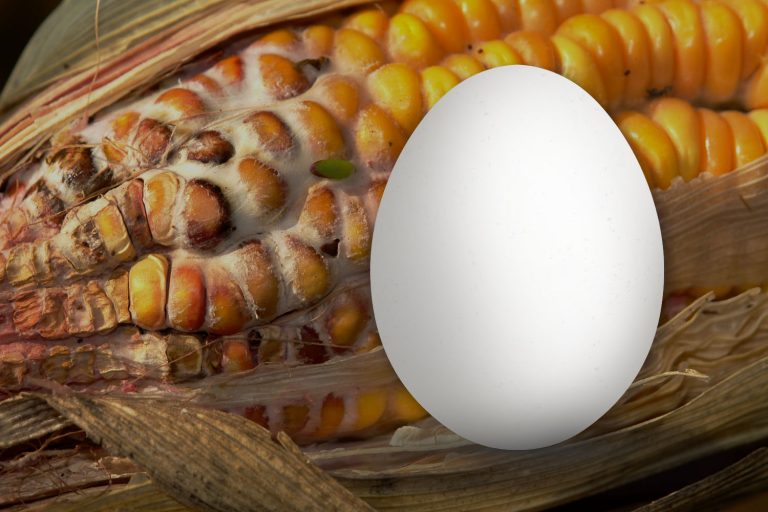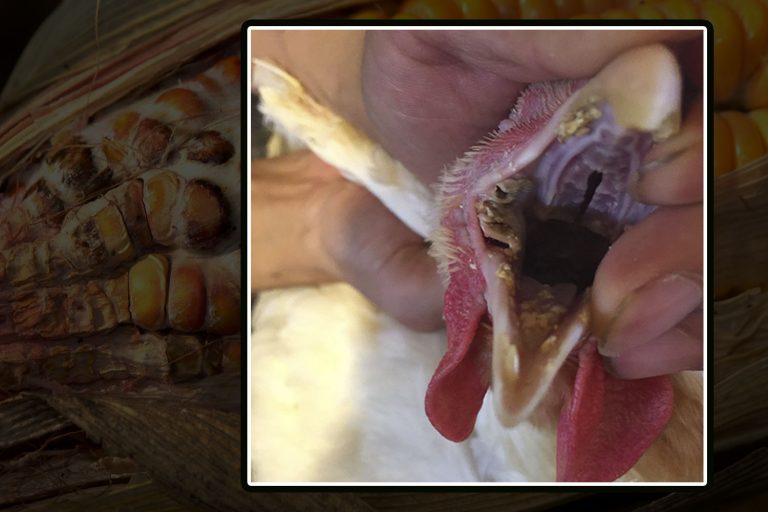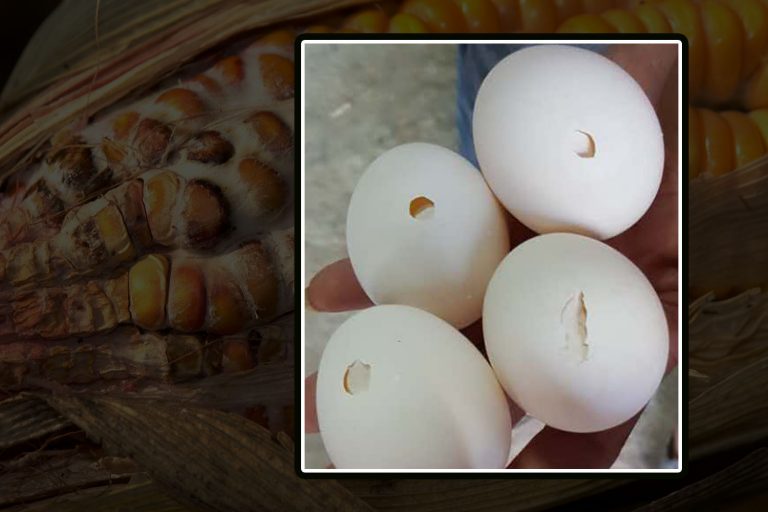27 Dec Toxicity by mycotoxins in laying hens

Contamination by mycotoxins impairs the health of the hen, its productivity and egg quality
Contamination by mycotoxins has a negative impact on the economic return of egg producers, not only due to productivity losses, but also because of its consequences on the health of the layers and on egg quality.
Laying hens are more susceptible to mycotoxins than broilers for three main reasons:
- A longer life makes laying hens the ideal candidates for chronic mycotoxicosis, caused by continuous exposure to low levels of toxins.
- Layer feeds often include by-products like DDGS, that are usually more contaminated than corn.
- Layers are subject to frequent stressful practices. The negative consequences of stress, such as immune deficiency, exacerbate the consequences of mycotoxins.
Toxicity of mycotoxins on the health of the hens
1. Gastrointestinal lesions
Cyclopiazonic acid and trichothecenes (T-2 toxin, HT-2 toxin, deoxynivalenol, monoacetoxyscirpenol and diacetoxyscirpenol) are irritating and produce lesions in different parts of the gastrointestinal tract, leading to decreased feed intake, impaired FCR and presence of undigested feed in the intestine.
T-2 toxin and diacetoxyscirpenol are the main mycotoxins responsible of lesions in the beak, tongue and palate.
Lesions in proventriculus and gizzard are mainly caused by T-2 toxin, HT-2 toxin, deoxynivalenol and diacetoxyscirpenol. Fumonisins are associated to enlarged proventriculus.
Ulcers and hemorrhages in the intestinal mucosa are commonly associated to the group of trichothecenes.

2. Digestive diseases and diarrhea
Ochratoxin, aflatoxins and trichothecenes are possible causes of feed passage.
The negative effect of deoxynivalenol on the intestinal epithelium is a predisposing factor for necrotic enteritis.
Ochratoxin, oosporin and citrinin impair kidney function, which makes the bird drink an excessive amount of water and may lead to wet droppings.
3. Skeletal problems
An adequate supply of calcium and phosphorus in a ratio of 2:1 is key for the health of the skeleton, as well as for the quality of the eggshell. Vitamin D3 is also involved in bone and eggshell formation because it regulates the absorption and metabolism of calcium.
Aflatoxin B1 and T2 toxin interfere with the absorption and metabolism of vitamin D3. Therefore, whenever feed is contaminated with mycotoxins, it is advised to increase the dose of vitamin D3.
Other mycotoxins such as ochratoxins, aflatoxins and citrinin impair the renal clearance of urates. Crystals of urate may precipitate in the joints, leading to articular gout.
4. Immunosuppression
Aflatoxins, trichothecenes and ochratoxin, at levels that do not cause signs of mycotoxicosis, suppress immune function, decreasing the resistance to infectious diseases and causing vaccination failures.
Worsening of productive parameters
It is calculated that contamination by mycotoxins impacts layer farms reducing the amount of eggs produced by 0.08 eggs/hen/week, on average.
- Aflatoxins, ochratoxins, deoxynivalenol, T-2 toxin and HT-2 toxin decrease the laying rate.
- Fumonisins and trichothecenes worsen feed conversion.
- Ochratoxins delay sexual maturity in pullets.
- Zearalenone at very high doses causes hormonal disorders, prolapse of the oviduct and enlargement of the cloaca.
Negative effects on egg quality
1. Reduced egg size
Contamination by aflatoxins, ochratoxin and deoxynivalenol results in smaller eggs.
2. Eggshell defects
- As explained above, aflatoxin B1 and T2 toxin interfere with the absorption and metabolism of vitamin D3 and reduce eggshell weight.
- Aflatoxin B1 lowers the deposits of vitamin A in the liver of the laying hens. Vitamin A is a key vitamin in the process of eggshell formation.
- Diacetoxyscirpenol, T-2 toxin and fumonisins increase the percentage of thin-shelled and cracked eggs.
- Ochratoxins produce yellow-brown stains in the eggshell due to the deposits of urate in the cloaca.
- Long term exposure to deoxynivalenol results in a higher occurrence of soft eggs.

3. Pale yolks
Ochratoxins, aflatoxins, fumonisins and trichothecenes interfere with the absorption of carotenoids in the intestine and with their metabolism in the liver, resulting in pale yolks.
On the other hand, contamination by aflatoxins may result in smaller egg yolks due to the interference of these mycotoxins with the metabolism of fats.
4. Blood spots
Contamination by aflatoxins is linked to a higher occurrence of blood spots in the albumen. Blood spots are the result of a small hemorrhage near the ovarian follicle during the ovulation. Aflatoxins have hemorrhagic effect.
5. Watery whites (poor Haugh unit values)
Long term exposure to aflatoxins and deoxynivalenol impairs the quality of the albumen, that becomes watery.
6. Mycotoxin residues in table eggs
Aflatoxin B1, aflatoxinol, deoxynivalenol and T-2 toxin accumulate in eggs although usually they do not pose a significant risk for human health.
7. Microbiological contamination
Chronic low-level ingestion of mycoxins results in increased digestive infections that may lead to egg contamination by E.coli or Salmonella sp.
Conclusions
Laying hens are more sensitive than other poultry to mycotoxins. The health of the layer, its productivity and the quality of the egg are affected.
Nowadays there is no technology which can fully prevent the mycotoxin contamination before or after harvest of the grains. It is necessary to set up a HACCP program to control mycotoxin contamination in layer feeds and to routinely use a suitable mycotoxin binder.
Products of choice
PlusBind© is a mixture of carefully selected silicates intended for the prevention of diseases and productivity losses related to the presence of all types of mycotoxins. It is indicated in poultry, pigs, aquaculture and ruminants.
The silicates present in PlusBind© have a highly expandable molecular structure. This characteristic gives the product a wide surface available for the adsorption of mycotoxins and therefore allows a high effectiveness at lower doses (0.5-1 kg per ton of feed).
PlusBind Bio© is a mixture of carefully selected silicates intended for the prevention of diseases and productivity losses related to the presence of all types of mycotoxins. It also contains plant extracts with prebiotic effect.
It is indicated in poultry, pigs and aquaculture.
The silicates present in PlusBind Bio© have a highly expandable molecular structure. This characteristic gives the product a wide surface available for the adsorption of mycotoxins and therefore allows a high effectiveness at lower doses (0.5-1 kg per ton of feed).

Certain health statements may not be applicable in your region.

